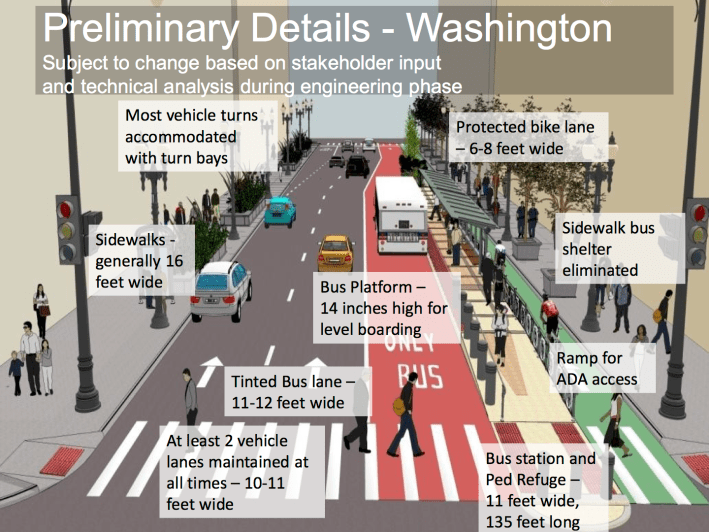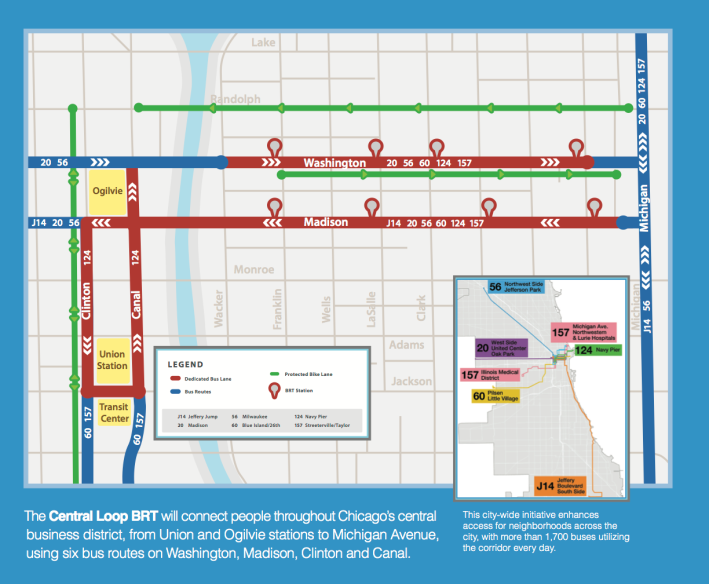
The Central Loop Bus Rapid Transit project will launch without key features that distinguish BRT from conventional bus service. The busways, which the Chicago Department of Transportation will begin building later this year, will include most of BRT's concrete features, like high-level bus-boarding platforms and dedicated lanes. These features will undoubtedly speed up six Chicago Transit Authority bus routes as they traverse the Loop.
However, key service improvements, which have been proven to speed up buses elsewhere, will only be "tested" in 2015, and their eventual adoption is far from certain. The initial absence of these features, namely off-board fare collection and signal priority, will knock Central Loop BRT down to a mere "basic" BRT system, using the methodology behind a new international standard meant to encourage effective, quality BRT.
At a May event, sources said that CDOT and CTA will "test" off-board fare collection at only one of the system's eight on-street stations. At all other stations, riders will pay on the bus, one at a time, just like they now do on all CTA buses. CDOT would not comment on what the test will entail, how long the test will run, or how it will be evaluated. A test involving just one station, out of hundreds of bus stops along the routes, could confuse customers even more than a test at all eight BRT stations -- and will offer only minimal travel time savings.
Collecting fares at the stations, before passengers board the bus, has been proven in several other cities to substantially reduce "dwell time," or how long a bus waits at stops. In New York City, BRT features were added one at a time along the M34 route across Midtown Manhattan, which runs past the Empire State Building and Macy's. When just prepaid boarding was added, total travel time for the entire route fell 10 percent. On Manhattan's first BRT route, off-board fare collection alone reduced dwell times on New York City's M15 Select Bus Service route by 36 percent.
Even though San Francisco hasn't yet implemented any form of BRT, the city's transit agency recently adopted "all-door boarding" -- allowing passengers who've already paid (and have a valid transfer slip) or who will pay with a Clipper card (a contactless fare card, like a Ventra card or ticket) to enter buses through the rear door. As a result, dwell times fell by four seconds per stop, on average.
Another key technology that keeps BRT routes moving through heavily congested areas like the Loop is transit signal priority. Signal priority takes many forms, but the most far-reaching forms won't be part of Central Loop BRT. Last year, CDOT spokesperson Pete Scales said that full transit signal priority, which re-programs the signaling system to better accommodate buses, won't be included in Central Loop BRT. The J14 Jeffery Jump has signal priority as it travels through the South Shore neighborhood, but Scales said this technology is more appropriate for neighborhoods' bus stop spacing than in the "dense grid of the Loop." Sources also say that signal pre-emption, which allows buses to override normal signals, also won't be used in Central Loop BRT.
Central Loop BRT will, however, include queue jumps -- bus-only signals that turn green a few seconds before the other signals, and give buses a head start on other traffic where there's no bus lane ahead. These work somewhat like leading pedestrian intervals, which have been added to many intersections around Chicago and give pedestrians a slight head start before turning drivers get a green light.
A queue jump would be particularly useful at Canal Street and Washington Street, where there won't be an eastbound bus lane. It would allow buses in the right two lanes, departing from Ogilvie Transportation Center, to get a head start up the hill and over the bridge, instead of waiting to merge into regular traffic. The eastbound bus lane is planned to start just beyond there, at Wacker Drive. Queue jumps would also be useful at other intersections where buses leave the bus lanes to continue their routes (going from red to blue lines on the map below).

Both off-board fare collection and queue jumps are integral to many definitions of "bus rapid transit." The Institute for Transportation and Development Policy developed the BRT Standard rating scheme, which awards points to many elements of BRT systems. Those points can add up to a "basic BRT" designation, or to bronze, silver, or gold standards. ITDP, which has consulted on the Central Loop and Ashland BRT projects, developed the standard to inhibit "BRT creep" -- where cities propose projects that are BRT in name only, but don't offer any improvements over conventional local bus service.
Comparing the Central Loop BRT plan to the standard shows that the project meets the Basic standard for BRT -- but falls far short of reaching even the bronze rank. Points in its favor included having sufficiently long dedicated lanes (more than three kilometers), and queue jumps at intersections. Points could be deducted if there's not a good mechanism for keeping motorists out of the bus lanes, but I presumed there would be effective enforcement of the bus lanes.
The project received nearly all of the points available in ITDP's "Service Planning" category, which encourages frequent service -- and is perhaps a given, since CTA runs so much service downtown. Points in its favor include having multiple routes in the corridor (which improves transfer times), building it in the highest-demand part of the bus network, and having good hours of operation. The project also gained points for incorporating bicycle lanes and bike-share, and for being accessible to and integrated with other transit modes.
One reason why Central Loop BRT doesn't reach the bronze standard is because all of its routes – J14, 20, 56, 60, 124, and 157 – are squeezed into a single lane. That has the potential to reduce the speed gains achieved by other BRT characteristics. CTA and CDOT are aiming for ITDP's gold standard with Ashland BRT, which collects dozens more points because it will only have a single route, running down a center lane, and will prohibit motorists from turning across its path when the buses are approaching intersections.
It's certainly reasonable for CDOT and CTA to implement off-board fare collection and queue jumps – essential to basic BRT – slowly at first, to iron out operational problems before going full steam ahead. However, this shouldn't become a permanent situation, and time-saving "software" should be rolled out quickly to fulfill the project's promise. I asked CDOT spokesman Pete Scales for more details about which station would have off-board fare collection, and about CDOT's plan to expand it to more locations, but he did not comment.
Scales did give an update on the construction schedule, though, saying "the [utility companies] are already underway with making the necessary upgrades," and that CDOT will "solicit bids for the roadway reconstruction and station installation." He said that the stations will be manufactured over the winter.




